#it's so hard to find kimono mods that look good/are accurate. I have to rely on vanilla only sobs
Explore tagged Tumblr posts
Text


Journey to the Hanamachi
#ffxiv#ffxiv screenshots#au ra#kugane#relight made these look so good im so happy about them#and how the ground looks a bit wet as if it were raining... muwah#it's so hard to find kimono mods that look good/are accurate. I have to rely on vanilla only sobs#gpose
26 notes
·
View notes
Note
so Kagura dresses like a dancer and Hakudoshi wears his 'suikan' like a noble. but i've never heard anything about what Kanna wears. the inuyasha wiki claims that both she and Shunran wear kimono but I'd like to know more if that's possible. sorry if you've already answered something like this before, but I can't even figure out how to work some of the websites in the research guide...
Thank you for actually checking out our Research Guide before asking (a lot of people don’t think to)! Sorry to hear you couldn’t find the answer that way on your own; let’s see what we can do to help...First, let’s get this out of the way: it’s technically never inaccurate to refer to traditional Japanese-type clothing like Kanna’s as “kimono” since it’s still a term used for it today. However, that’s very general - literally, the word originally meant just “thing to wear” (mono was “thing”, ki is one way of saying “wear”)...so in other words, my hand to god, at the time the story is set, it just meant “clothing”. Congratulations Kanna, you are wearing clothing! :DAh...not helpful? No, not helpful.All kidding aside, it’s true that the term as it’s used today is a little more specific, but it’s not by much: these days, even in post-Meiji era Japan, "kimono” refers to specifically “ethnically Japanese” i.e. traditional Japanese clothing (the more general term in the modern era for “clothing” in Japanese is apparently 被服, which we would romanize as hifuku)... but, that is still unhelpful because yes, we can see it’s “Japanese” clothing, but seeing as “Japanese clothing” refers to a REALLY broad swath of clothing ranging from furisode to yukata, suikan etc - it’s incredibly non-specific. In other words, almost as bad as calling both pants and skirts “hakama”; accurate, but not helpful in the least! :PSo. What IS she wearing?Well, I...am sorry to break it to you but I’m not entirely sure yet, anon. >_>Since I’m prepping for Hurricane Irma as I respond to this, I’m unfortunately unable to do that much poking around, but I will say I immediately noticed something interesting about it after looking up reference pictures, one of which was this screencap from the anime adaptation (which is I believe from "Kagura's Dance and Kanna's Mirror", from Season 2, in which Kanna first appears):
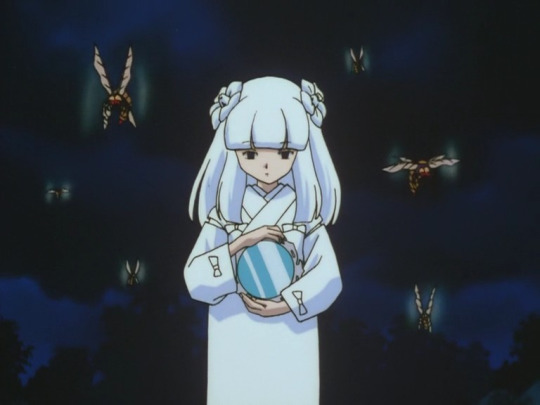
Actually, let’s summarize what I’m noticing here, which helps me tell you what it is definitely NOT, and hypothetically might be (or...I thought it might be, more on that in a moment):1.) Looking at the ends of the sleeves near the wrist I can tell her garment is NOT any kind of furisode (literally “swinging sleeve”) type kimono, which have long sleeves that hang down (Sesshomaru’s top, for comparison, is a furisode).2.) Her sleeves are more like those found on the kimono type called a kosode (literally “small sleeves”). They are meant to not get in the way, in other words (Sango wears a kosode when she’s not just wearing her armor by itself, for another comparison; you can see the end of the sleeve near the wrist is of similar design).
3.) SLITS IN THE SHOULDERS.I’m going to have to add some visual ref here to point out why this jumped out at me as a detail.This is a “standard” looking kosode:
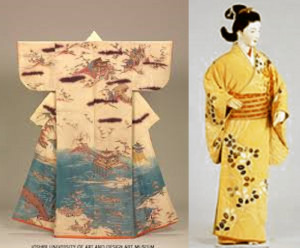
(image pulled from this nifty overview of the evolution of kimono! I recommend giving it a read, it’s very informative!)Now. Pay attention to the shoulders. Scroll back up, and compare - again, there are slits in Kanna’s kimono’s shoulders, but not in “standard” kosode designs.
Slits in that position on the shoulders aren’t at all unheard of in traditional Japanese clothing - they’re found in the suikan type garment that Inuyasha and Hakudoshi both wear, for instance, which as we’ve mentioned before, is designed for as a “hunting jacket” type garment, making me think that that’s why this garment of hers also has them? - but it’s not always a standard feature.(It’s also a feature in Kikyo’s outfit by the way:
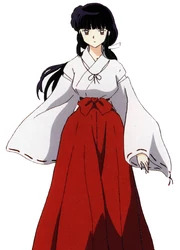
Kikyo is an archer, so it makes sense she’d enjoy the fuller movement that those slits provide! Why does Kanna need it though if she relies on her soul-sucking mirror as her “weapon”? Hm. Good question!)Oh -and one more thing. Which I almost missed but which kicks it out of just “kosode” into “okay no, this is a fair freaking question, what IS this??”Look at this other screenshot from the anime I ran across when trying to see “what her obi looked like”:
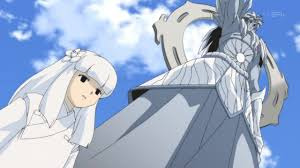
What in the....there’s. Wait. No. That - can’t be.....?*googles more screenshots, confirms*
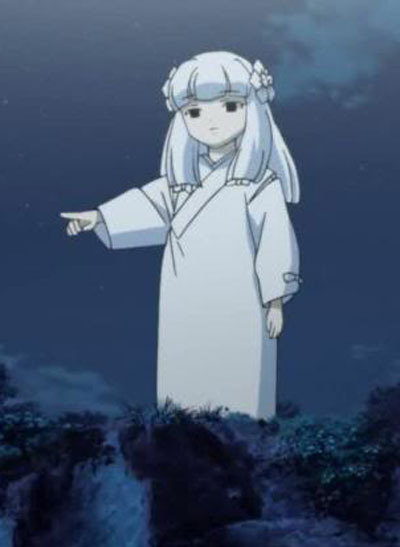
THERE’S NO OBI.NONE. AT ALL. WHATThere’s no belt?? Where’s the ties?? Is this even a real old-school kimono style or at this point is Takahashi kind of just making it up because “hey it’s a youkai anyway so whatever”? Is it tucked up in there?? How is this even staying in place...? (There’s also those little bows to consider, granted - but I feel like most of those are probably decorative? - but it’s hard to tell, without knowing what the garment even is! Maybe they’re not! Schrodinger’s bows)Okay, Anon. Yes. I see now why you sent this in. I SEE it. I never looked closely at her outfit before and now that I have, I am so far baffled. o_O All in all, I’m not sure exactly what is up with Kanna’s outfit - not 100%. But I do find it interesting (and probably notable!) that it has slits in sleeves, and that it’s clearly not held in place with a normal old-fashioned obi, as we think of one at least. It’s possible (just spit-balling here, especially with Hakudoshi “wearing his suikan like a noble”, and Naraku’s having taken over a noblemen’s place!) that it’s a REALLY old-fashioned noble class children’s outfit? Maybe? That might be a good avenue for research (and I probably would have tried it, were I not prepping for a major hurricane this weekend, sorry anon! ^^;;). I wouldn’t even be surprised if it would be old-fashioned even by Sengoku era standards, mind - we know Takahashi included a by-then-“old-fashioned” suikan for Inuyasha (and Hakudoshi) and put Inuyasha’s very much human mother in a junihitoe (the latter is more like from the Heian period, MUCH earlier), so you never know. Keep it in mind!I will say this though:The more I think about it, the more I find it extremely interesting, too, that the ENTIRE outfit - outer garment, undergarment (which she does have; you can see it under her collar, peeking out through the sleeve-slits, and if you saw a full-body shot that showed her feet, peaking out from under the bottom of her outer garment as well)... the bows on the outfit... even her very hair, and even the decorations in her hair! - All, ALL of them, are solid, pure, non-patterned white.Why do I find this so striking?Because of the various nuanced implications of that in Japanese culture (warning: this link includes a picture of a Japanese corpse being prepped for burial. It’s actually not gross looking at all, but you may find it spooky or unsettling when you realize what it is, so I feel a need to warn ahead of time).Now, despite what the warning in parentheses for that link might seem to imply, and despite what some rumors may say, “death” isn’t the only association with white (and especially white clothing) in Japanese culture; it’s associated with “purity” and cleanliness as well. People aren’t just buried in white, they’re often married in it, too, and many priests and priestesses in Shinto and Buddhism include white clothing in their garb, especially for specific rituals requiring “purity”.I also will clarify that that is NOT a funerary kimono, in the sense that she’s wearing it folded the normal way, and not the opposite way, which corpses are dressed in, so let’s clear that up right away, that she’s not dressed “like a corpse”. At all. But.Still...This feels like it can’t be coincidental...? It’s hard to tell if the white theme is a sign of her “blankness”/emptiness (which is another fair possibility), or if it’s indeed meant to evoke those other WELL known elements in Japanese spiritual beliefs (and it’s still noteworthy I think that to the Japanese, it IS still common to see ghosts wearing solid white, because they are still buried in white, so there’s the subconscious “creepy factor” too, sure)...hn. It’s a real question!I am starting to doubt that it was purely for aesthetics or to save on ink though :P So basically the short answer is: I am real sorry anon, I have no idea. :( I wish I did!The long answer, clearly, is: “WAIT, THIS RAISES EVEN MORE QUESTIONS...??”-Mod VorpalGirl(PS: I probably will not be online the rest of this weekend, at least on here. Seriously, Irma is making her cranky way right up my home State and we decided not to evacuate sooooo. Not only do we need to prep like heck tomorrow, power will likely go out for us before Monday, and given what happened with Hurricane Matthew last year, that could keep me away from ya’ll for up to a week or so. >_> Wish me luck....and Tekka too, since she’s still likely in the path of it as well)
22 notes
·
View notes